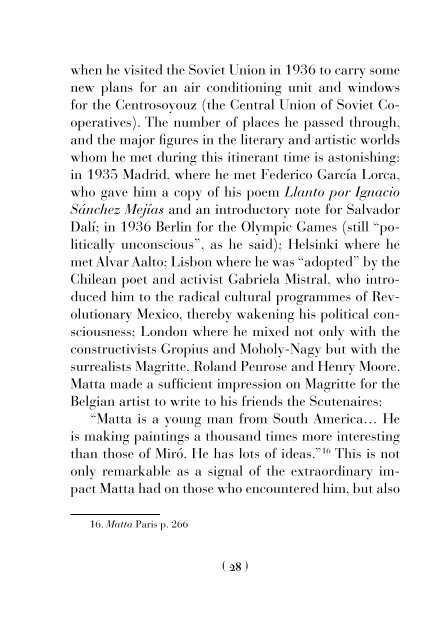Matta-Duchamp
Illustrated catalog featuring full page color illustrations and rare documentary photographs. Published by Galerie Gmurzynska in June 2018 to accompany a special cabinet exhibition at Art Basel 2018. The book includes texts by Professor Dawn Adès and Norman Rosenthal. It coincides with a broader re-evaluation of the importance of Matta internationally as well as of the influence of Duchamp on the work of 20th century artists. Edited and introduced by Krystyna Gmurzynska and Mathias Rastorfer. Essays by Dawn Adès and Norman Rosenthal. Historic interview excerpt by Robert Motherwell. 90 pages with 7 illustrations. Softcover. ISBN: 978-3-905792-09-6
Illustrated catalog featuring full page color illustrations and rare documentary photographs.
Published by Galerie Gmurzynska in June 2018 to accompany a special cabinet exhibition at Art Basel 2018. The book includes texts by Professor Dawn Adès and Norman Rosenthal. It coincides with a broader re-evaluation of the importance of Matta internationally as well as of the influence of Duchamp on the work of 20th century artists.
Edited and introduced by Krystyna Gmurzynska and Mathias Rastorfer.
Essays by Dawn Adès and Norman Rosenthal.
Historic interview excerpt by Robert Motherwell.
90 pages with 7 illustrations.
Softcover.
ISBN:
978-3-905792-09-6
You also want an ePaper? Increase the reach of your titles
YUMPU automatically turns print PDFs into web optimized ePapers that Google loves.
when he visited the Soviet Union in 1936 to carry some<br />
new plans for an air conditioning unit and windows<br />
for the Centrosoyouz (the Central Union of Soviet Cooperatives).<br />
The number of places he passed through,<br />
and the major figures in the literary and artistic worlds<br />
whom he met during this itinerant time is astonishing:<br />
in 1935 Madrid, where he met Federico García Lorca,<br />
who gave him a copy of his poem Llanto por Ignacio<br />
Sánchez Mejías and an introductory note for Salvador<br />
Dalí; in 1936 Berlin for the Olympic Games (still “politically<br />
unconscious”, as he said); Helsinki where he<br />
met Alvar Aalto; Lisbon where he was “adopted” by the<br />
Chilean poet and activist Gabriela Mistral, who introduced<br />
him to the radical cultural programmes of Revolutionary<br />
Mexico, thereby wakening his political consciousness;<br />
London where he mixed not only with the<br />
constructivists Gropius and Moholy-Nagy but with the<br />
surrealists Magritte, Roland Penrose and Henry Moore.<br />
<strong>Matta</strong> made a sufficient impression on Magritte for the<br />
Belgian artist to write to his friends the Scutenaires:<br />
“<strong>Matta</strong> is a young man from South America… He<br />
is making paintings a thousand times more interesting<br />
than those of Miró. He has lots of ideas.” 16 This is not<br />
only remarkable as a signal of the extraordinary impact<br />
<strong>Matta</strong> had on those who encountered him, but also<br />
16. <strong>Matta</strong> Paris p. 266<br />
( 28 )

















